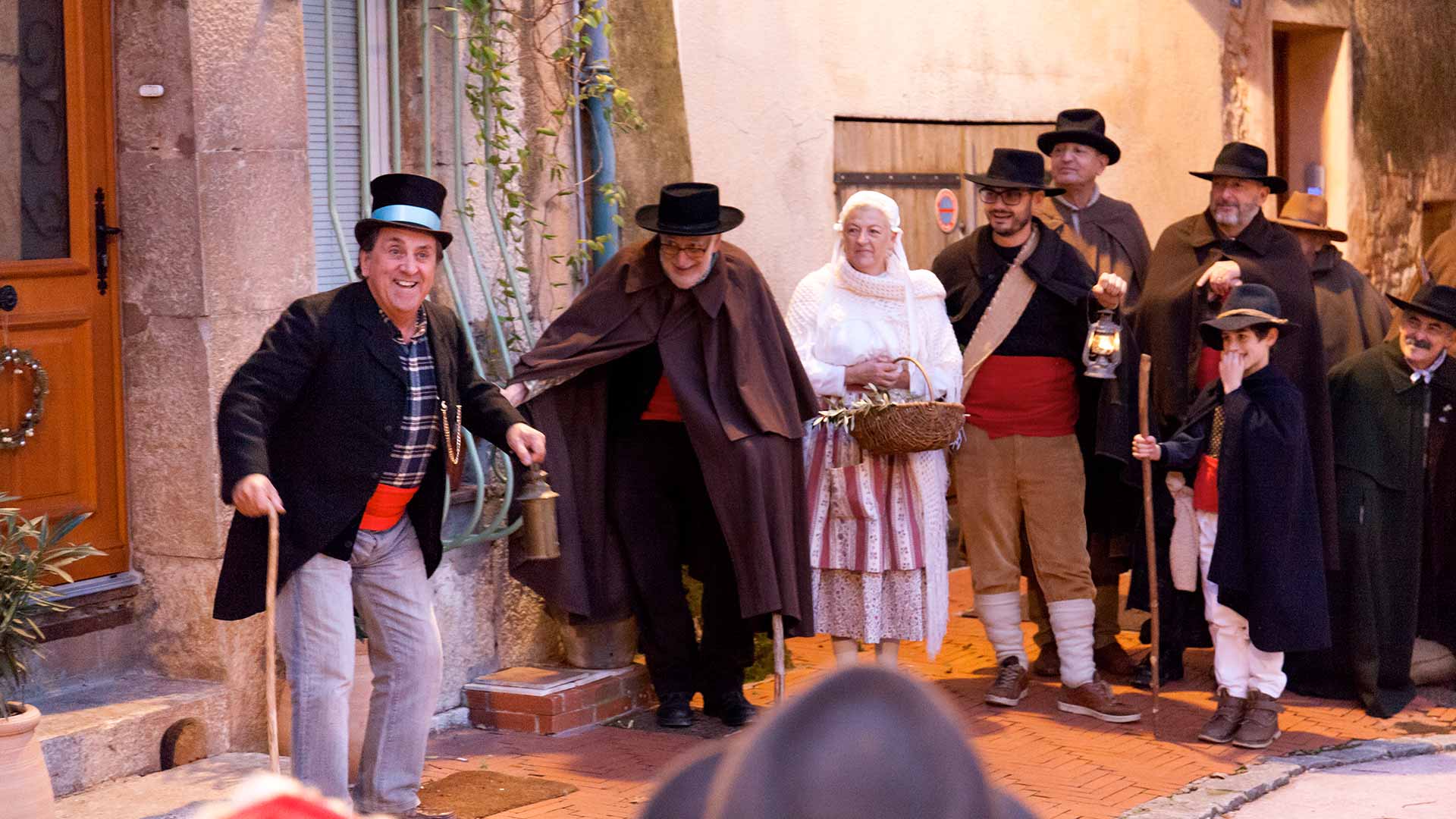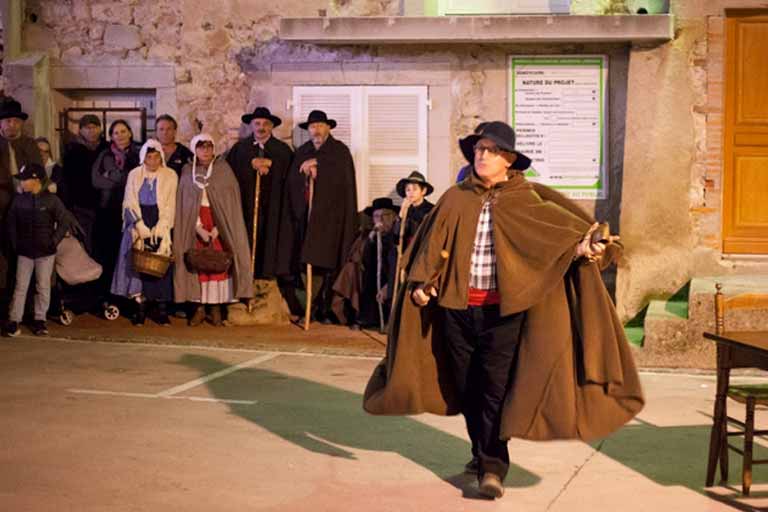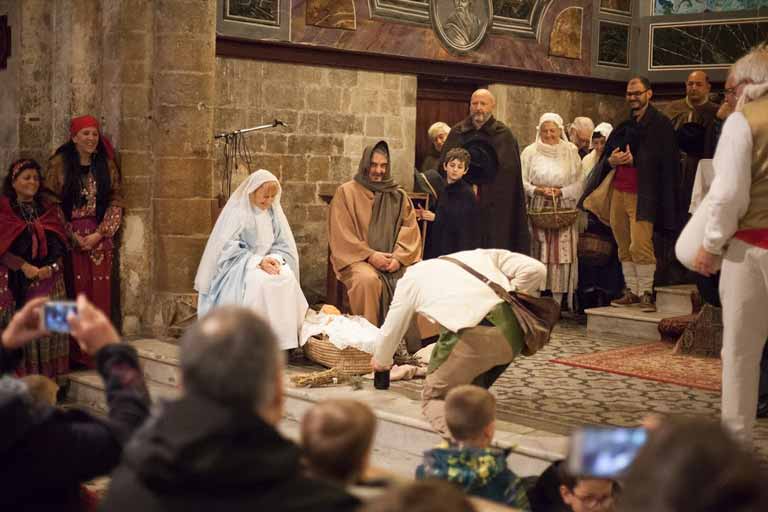
the story of Christmas in Provence
Christmas is a very special time of the year in Provence. The so-called crèche villages are adorned with festive colours and lights. Town centres and sanctuaries prepare to welcome THE Provencal tradition par excellence: “La Pastorale”. But you may ask, what is it? Similar to the nativity scene, but it is a spoken and sung nativity play whose backdrop is the village itself and whose actors are the villagers. Not all villages organize their own nativity play, so get in touch with the nearest tourist office for information. It is performed from 15 December to 15 January – and there is even one on 24 December. The choice is yours
THE MAUREL PASTORALE IN 4 ACTS
There are several Provencal nativity plays, but the best known is the Maurel. It was created in 1844 in Marseille. Traditionally, the first three acts are in Provençal dialect and the fourth is in French.

ACT 1: AN IMPORTANT ANNOUNCEMENT IS MADE
The first act tells the story of the announcement of the birth of Jesus to the shepherds, followed by the presentation of the characters and their idiosyncrasies.
ACT 2: THE NEWS GETS AROUND...
It portrays the arrival of the characters in the centre of the village to spread the word.
ACTE 3 - THE FEAST
Act 3 takes place in Benvengu's home - the master and owner of a large farm who never misses an opportunity for a celebration. This when THE most famous scene takes place: Pistachié falls into the well. In addition the angel Gabriel confirms the news and guides the merry band to the stable (crèche).
ACTE 4 - ALMOST FORGOTTEN
This last act, which is performed in French, is rarely played nowadays because of its religious nature. It is about adoration, offerings and miracles. The play finally ends with a song expressing the joy of the people of Provence.
A REAL TRADITION

Although initially the plot of the play was underpinned by religious fervour, with the decline in the use of the Provençal dialect, Maurel's Pastorale gradually became more and more identity-based and less and less religious. Today, despite the fact that each village has its own version, they are all based on Maurel's and are performed in the language of the Mistral. A narrator describes the scene in French so the whole audience can enjoy the show.
THE MAIN CHARACTERS IN LA PASTORALE
So you can enjoy the show to the fullest, we've given you the main storyline. Here are the portraits of the main characters. Don't lose sight of the fact that La Pastorale is a living nativity scene. So, even if we don't find all the santons, the main ones are there. Play as a family, try to recognize each of them in the nativity scene.
THE ANGEL BOUFARÉU
Posted on the roof of the stable, he blows his trumpet towards the village to announce the news to the shepherds.
THE SHEPHERD
Wrapped in his large cape that protects him from the rain and the Mistral, a gourd or accordion hanging from his shoulder, he clutches a stick in one hand and has a lamb under his other arm.
THE MAYOR
Also called "Lou Cose" in Provençal. He is dressed like a lord and wears his tricolour scarf and a gold watch hanging from his jacket pocket. He is the symbol of the Republic in this production. In fact, he will enter the birth of Jesus in the register of births, deaths and marriages.
THE PARISH PRIEST
He is bald and potbellied, smiling and chubby. Very often, he is in the process of wiping his forehead.
THE DRUMMER
He carries a drum and traditional pipe and leads the procession. He is dressed in an elegant costume, wears a wide-brimmed felt hat, a black velvet jacket, a white shirt tied at the collar by a cord and an embroidered waistcoat. His belt, a "taiole", in Provençal, is made of a strip of red woollen cloth.
PISTACHIÉ
He is a simple farmhand, a womanizer. His name comes from the tree that produces pistachios, which, it is said, are an aphrodisiac. He carries a basket in each hand: the first one is overflowing with salt cod and sausage, the second one with fougasse and an olive oil brioche. He is married to the fishmonger: Honorine.
MARGARIDO
She is old and cantankerous. She never misses an opportunity to scold her husband. She is reputed to have a bad temper.
MONSIEUR JOURDAN
He is Margarido's husband. He is a pleasant middle-class man, the victim of his wife who has a strong character. Their domestic disputes are incessant. An elegant man, he took the time to put on nice trousers, an embroidered waistcoat and to adorn himself with a neckerchief and a gibus (top hat) before leaving home.
THE MILLER
The shepherd hears the message on the hill and goes down to the village with his flock. The miller is the first in the village to hear the message and he comes out of his mill with a sack of flour on his back and is the first to return to the village. He is very often accompanied by his dog and his donkey.
ROUSTIDO
An old bachelor, he is a little deaf and hears the shepherds' call later than the others. He found himself almost alone in the village in the middle of the night. He carries a lantern to go and wake up his neighbours Margarido and Monsieur Jourdan.
THE BLIND MAN
he has had a tragic life. He had two sons, Simon and Peter, but the Boumian took Peter away from him and he never saw him again. He cried so much that he lost his sight.
THE BOUMIAN OU THE BOUMIANE
They are Romany gypsies that the Count of Provence forced to live in Sainte Baume.
To find out where to see a performance, visit www.provenceverteverdon.fr the section “agenda”.